This German pretzel recipe (lye pretzels) will give you perfectly soft, fluffy, chewy pretzels. Lye is a must for a glossy brown crust and classic pretzel flavor.
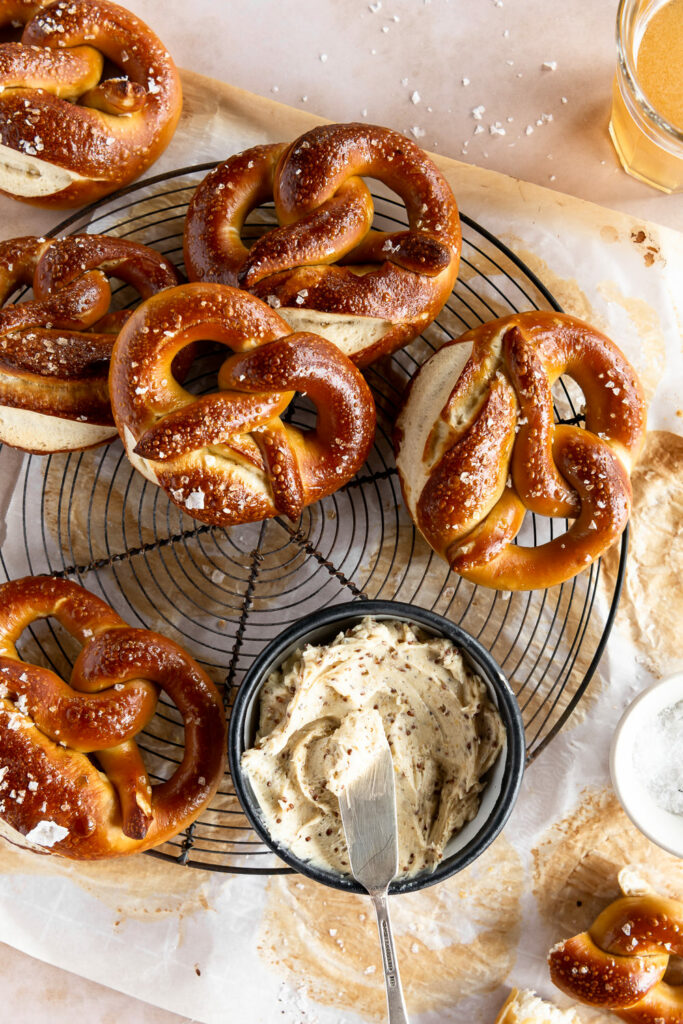
This post may contain affiliate links. As an Amazon Associate, I earn from qualifying purchases.
Pretzel recipes are a dime a dozen. And sadly, there’s nothing particularly special about the vast majority of them. I bet most pretzels you’ve eaten are lackluster too— even if you’ve made them from scratch. Generally, the dough is dry and crumbly, they're a little tough, and the amount of pretzel salt on them is a choking hazard.
So when my mom surprised me with a jar of lye (yes, she’s that cool), I knew I needed to find a German pretzel recipe that was worthy. After a lot of research and trials, I stumbled on Pretzel Making at Home by Andrew Slonecker. Her book is filled with tips, ideas, and the most beautiful recipe for soft lye pretzels.
They’re fluffy, chewy, and almost silky in texture. The dough is absolutely gorgeous and will make you a pretzel snob for the rest of your life.
A big problem, too, is that almost every pretzel recipe on the internet assumes you’re too chicken to use lye. They talk about baking soda (sodium bicarbonate) or baked baking soda (sodium carbonate) as a suitable substitute for home cooks.
Well, let me tell you. Neither come close. I’ll never go back to baking soda pretzels— the hot lye bath is an essential component to German pretzels. Don’t skip it. And don’t be afraid. Educate yourself on safe techniques, pay attention to what you’re doing, and remember that people have been making lye pretzels for hundreds of years. You can too.
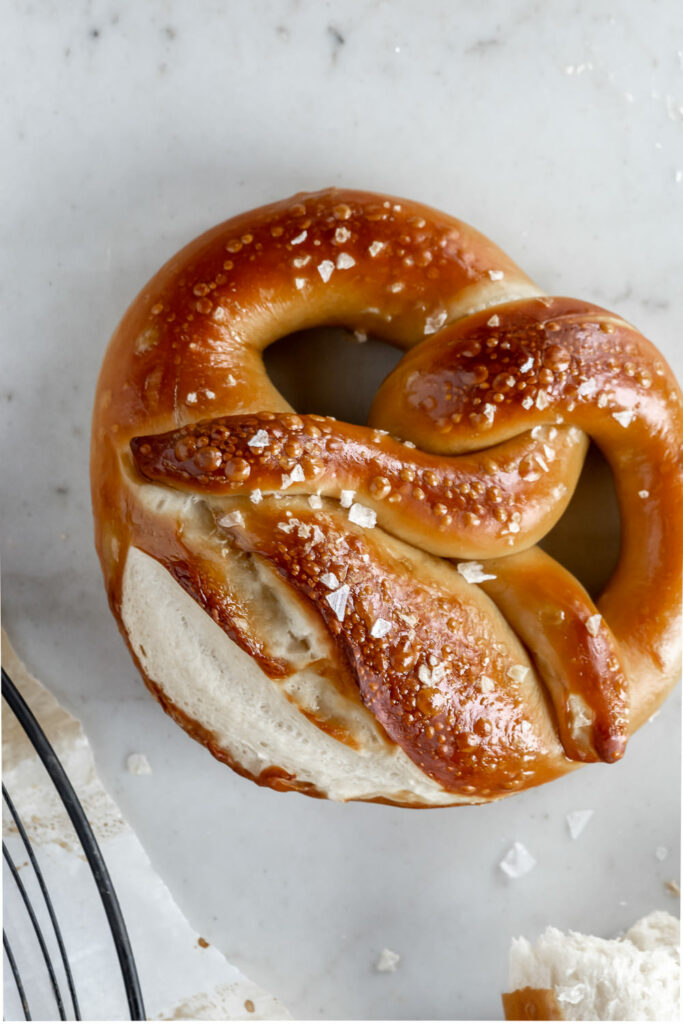
how do you make German pretzels from scratch?
- Make the pretzel dough, which will be stiff and a little tacky.
- For the best flavor, refrigerate the dough and let it rise 8- 30 hours. For quick pretzels, let rise until doubled, about 2 hours.
- Deflate dough and shape into pretzels.
- Let rise 20- 30 minutes, until puffy but not doubled.
- Dip pretzels in a hot lye bath for 10 seconds per side.
- Brush with egg wash, sprinkle with flaky salt, score.
- Bake for 8- 10 minutes at 500°F.
- Serve with mustard butter or your favorite cheese sauce.
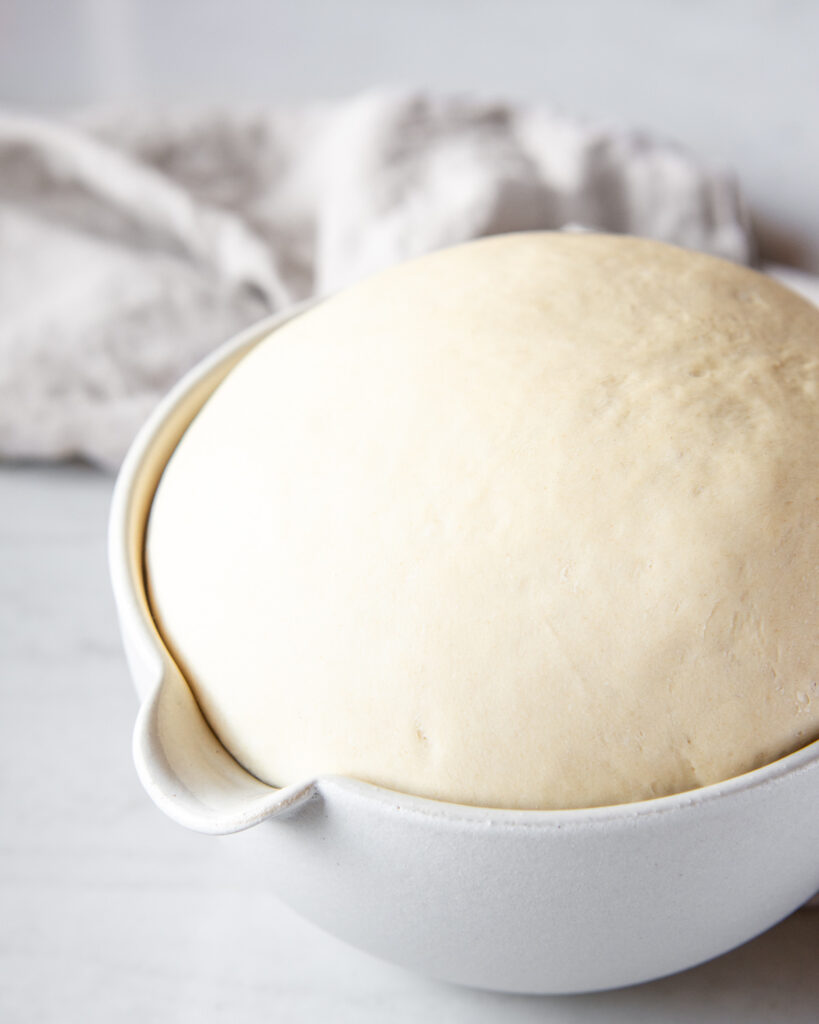
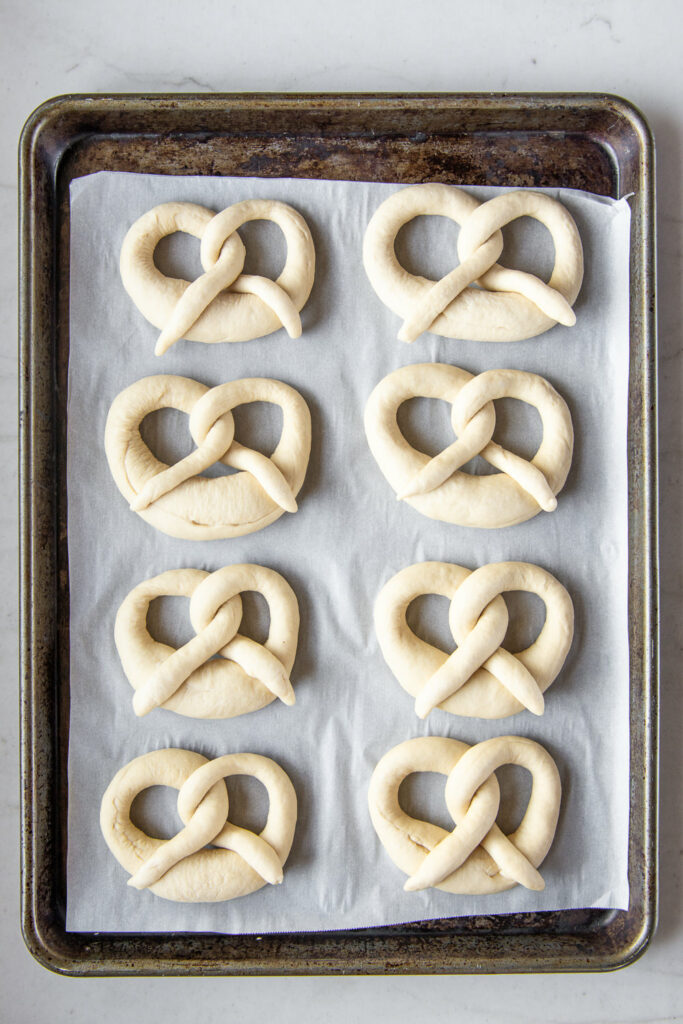
how do you shape pretzels?
- Flatten dough into a rectangle, about 3 inches by 5 inches.
- Roll the rectangle into a tight tube, starting with the long edge.
- Pinch seam together.
- Roll out tube. Leave about 2 inches in the center unrolled for the "belly". Firmly press down and out, until pretzel dough measures about 26 inches long. Let rest a few minutes, if needed, then continue to roll out when dough has relaxed.
- Form the rope into a "U" shape. Cross the arms twice, about 3 inches from the ends, then fold down and press the ends of the rope at 4 o'clock and 8 o'clock on the pretzel.
- Transfer to a parchment-paper lined baking sheet to rise. Repeat with remaining dough.
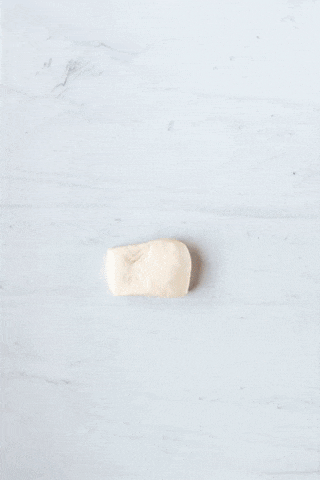
why are pretzels dipped in lye?
Lye is the secret ingredient that gives pretzels their characteristic look and taste. Without lye, you have a breadstick. When you dip raw dough into a hot lye bath, the lye breaks down proteins and starches on the surface. The dough is baked at a high temperature, which allows the small peptides, amino acids, and sugars to react and produce a deep brown, shiny, flavorful crust.
Below is a photo that compares a lye pretzel (left) with a baking soda pretzel (right).
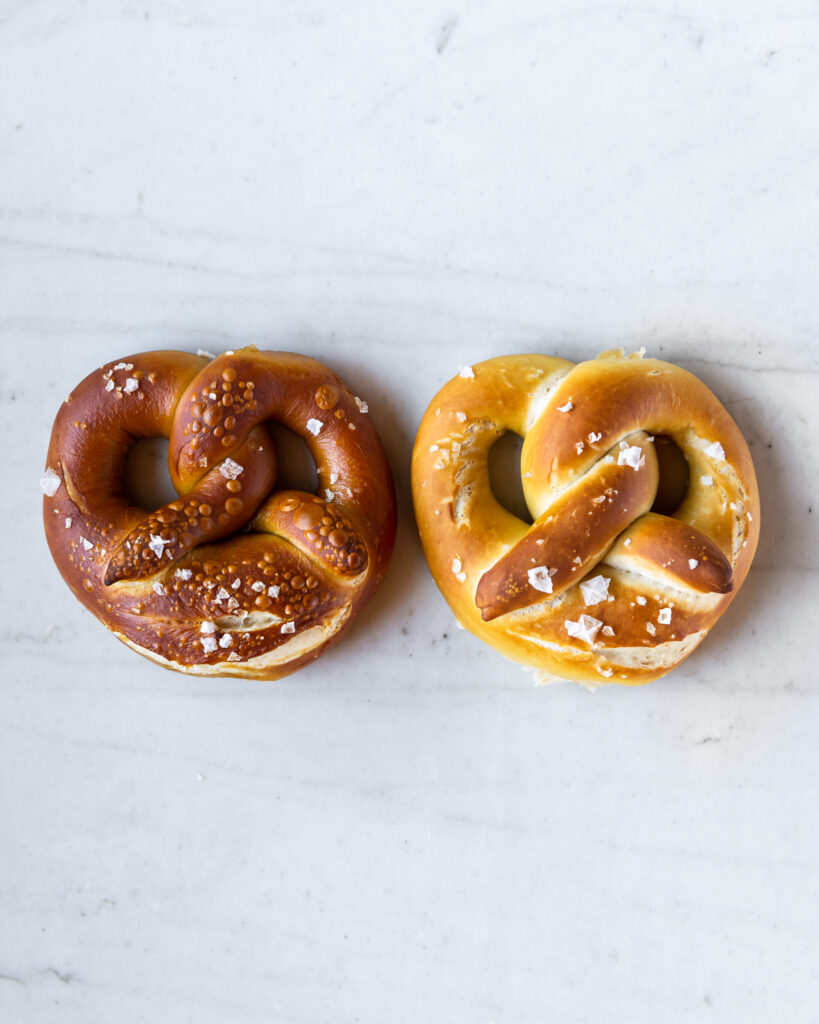
are lye pretzels safe to eat?
Yes. The technique of dipping raw dough in a lye bath has been used in Germany for at least two-hundred years. And they eat all types of lye-dipped bread every day. The lye bath is a very dilute 1% solution, and the raw pretzels are only submerged for about 20 seconds. The lye (NaOH) reacts with acidic protein groups on the surface of the dough, in addition to carbon dioxide and water in the oven. By the end of baking, lye pretzels are harmless and perfectly edible.
what can I use instead of lye?
If you can’t source lye or don’t want to use it, you have two options. The most benign substitute for lye is baking soda. You’ll get a little bit of browning and some chew, but don’t expect it to taste very pretzel-y. You can also used baked baking soda, which is a stronger alkali than baking soda but not as caustic as lye.
baking soda pretzels:
Combine 2 tablespoons baking soda in 1 cup of boiling water. Let the unbaked pretzels sit in the bath for 2 minutes, then brush with the egg wash, sprinkle with salt, score and bake.
baked baking soda pretzels:
Line a baking sheet with aluminum foil and spread out ⅔ cup of baking soda in an even layer. Bake for 1 hour at 250°F. Dissolve all of the baked baking soda in 2 cups of water. Dip the unbaked pretzels for 3 minutes and rinse with cool water. Brush with the egg wash, sprinkle with salt, score and bake as usual.
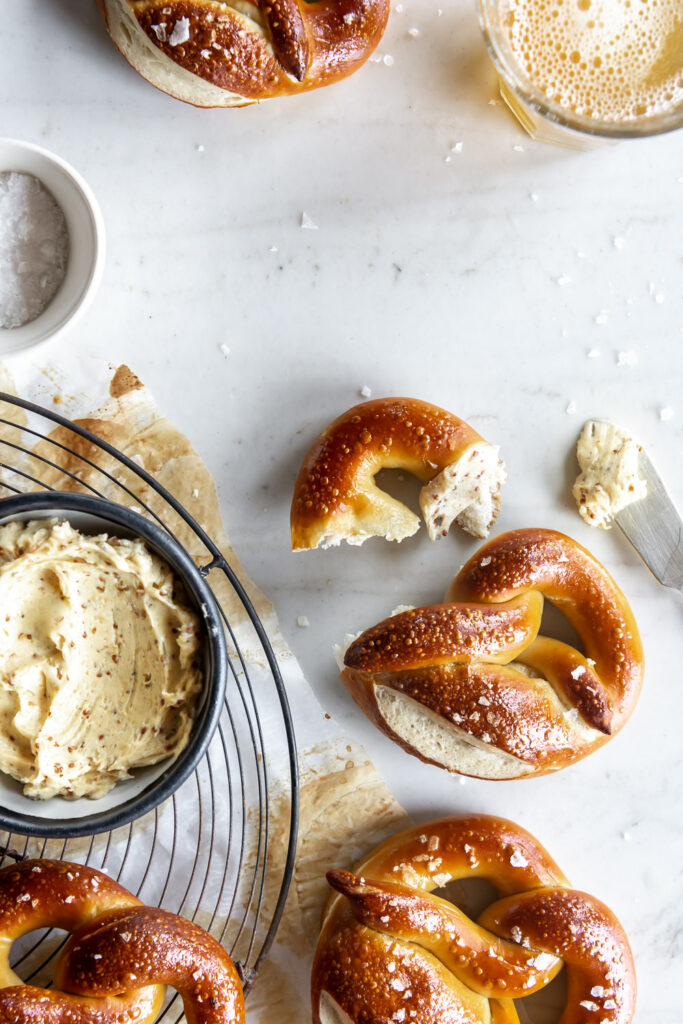
make ahead options for this German pretzel recipe:
- Pretzel dough can be refrigerated for up to 30 hours for a slow rise and development of complex flavors.
- Shaped pretzels can be refrigerated for up to 8 hours before dipping in lye and baking. Make sure to wrap the baking sheet tightly with plastic wrap.
- Pretzels can be baked and stored for 2- 3 days. Reheat in the oven at 350°F for about 5 minutes, or until heated through.
- Pretzels can be baked and frozen, wrapped tightly in plastic, for up to 2 months. Heat frozen pretzels in the oven for 10- 15 minutes at 350°F.
safety tips for making lye pretzels:
- Always add the lye to the water, not the water to the lye. If you add water to lye, you’re starting out with a highly concentrated and very dangerous solution, and then you’re diluting it. The reverse is much safer. Working with the dry lye is the most dangerous part. Pay attention! The lye bath can irritate your skin, but it’s a 1% solution and not nearly as concentrated as it is with soap making.
- Use food grade lye, which is regulated by the FDA to contain less heavy metal impurities.
- Buy food grade lye here.
- Ventilate your kitchen— turn on the hood and open windows to clear out the fumes.
- Don’t touch the lye or anything that has been in contact with the lye solution. I always put my utensils on a special plate, and then rinse everything with water and douse it with vinegar when I’m finished. This prevents the unconscious spread of lye on your counters, which you could lean on later and get burned by.
- Use a stainless steel pot for the lye bath, not a reactive metal such as aluminum, copper or cast iron.
- To dispose of the lye bath, pour it down the drain (it is a dilute Drano, after all), flush with water and pour some vinegar in your sink for good measure.
- Be smart. Don’t hover over the pot and breathe the fumes. Don’t let kids or animals run around in the kitchen. Store the lye in a safe place. If you’re nervous, wear eye protection and gloves. If you do get splashed with lye, rinse it off immediately and pour vinegar on top to neutralize the burn.
more snack recipes to try!
Printsoft german lye pretzels
This German pretzel recipe will give you perfectly soft, fluffy, chewy pretzels. Lye is a must for a glossy brown crust and classic pretzel flavor.
- Prep Time: 30 minutes
- Cook Time: 20 minutes
- Total Time: 50 minutes
- Yield: 8
- Category: Bread
- Method: Lye bath
- Cuisine: German
Ingredients
- ½ cup warm water
- 1 tbsp brown sugar
- 2 ¼ tsp active dry yeast (1 package)
- ½ cup beer (your favorite wheat beer, pilsner or lager)
- 3 ¼ cups bread flour
- 2 tbsp butter, room temperature, plus more for greasing
- 2 tsp kosher salt
- 2 tbsp food-grade lye
- 1 egg yolk beaten with 1 tbsp water, for egg wash
- Flaky salt (such as Maldon), for sprinkling
Instructions
- Pour water in the bowl of a stand mixer. Add brown sugar and whisk by hand to dissolve. Sprinkle yeast over the surface and let sit a few minutes, until foamy. Add beer, flour, butter and salt and stir with a large spoon until a shaggy dough forms. Knead by hand in the bowl a few times until dough comes together. It will be firm and slightly tacky. Add more water (a teaspoon at a time) if dough is very dry or more flour (a tablespoon at a time) if very sticky. Attach the dough hook and knead with the machine on medium-low speed until the dough is smooth, 5- 7 minutes.
- Grease a large bowl with butter and place dough inside. Cover with plastic wrap and refrigerate at least 8 hours, and up to 30 hours. For quick pretzels, let rise in a warm spot until doubled in volume, 1 ½- 2 hours.
- When the dough is ready, turn it out onto an un-floured work surface and gently deflate. Divide dough into 8 pieces. Cover dough pieces with a clean, damp dish towel and shape one piece at a time. Flatten the dough piece into a rectangle, about 3 inches by 5 inches. Starting with the long edge, roll the rectangle into a tight tube and pinch seam together. Roll out tube, leaving about 2 inches in the center unrolled for the "belly". Firmly press down and out as you roll, until pretzel rope measures about 26 inches long. Spritz your work surface with a bit of water, if needed, to prevent the dough from slipping. If the dough starts to spring back and resist the rolling, let it rest a few minutes and continue once it has relaxed.
- Form the rope into a "U" shape. Cross the arms twice, about 3 inches from the ends, then fold down and press the ends of the rope at 4 o'clock and 8 o'clock on the pretzel. Transfer to a parchment paper lined baking sheet. Repeat shaping remaining dough. Cover loosely with a clean dish towel and let rise 20- 30 minutes, until puffy but not doubled in size.
- Meanwhile, preheat oven to 500°F and prepare lye bath. Fill a large stainless steel pot with 8 cups of water. Carefully sprinkle in lye, then stir to dissolve. When pretzels are ready, heat lye bath over medium high heat until you begin to see steam rise from the surface. Turn off heat and begin dipping. Place a pretzel on a large skimmer and gently transfer it to the lye bath. Let the pretzel float for 10 seconds, then carefully flip it and soak another 10 seconds. Flip the pretzel so it’s right side up and return it to the baking sheet. If pretzel shape comes apart, put on gloves or use a fork to reposition it. Repeat lye dip with remaining pretzels.
- Brush pretzels with egg wash, sprinkle with flaky salt, and score the belly of the pretzel with a sharp knife. Bake for 8- 10 minutes, or until pretzels are a rich, glossy brown color. Let cool a few minutes, then transfer to a cooling rack. Enjoy!
Notes
Reheat in the oven at 350°F for about 5 minutes, or until heated through.
Store in an airtight container for 2- 3 days, or freeze, tightly wrapped, for up to 2 months. Heat frozen pretzels in the oven for 10- 15 minutes at 350°F.
Nutritional information is only an estimate. The accuracy of the nutritional information for any recipe on this site is not guaranteed.
Nutrition
- Serving Size: 1 pretzel
- Calories: 249
- Sugar: 1.5g
- Sodium: 608mg
- Fat: 4.5g
- Saturated Fat: 2.2g
- Unsaturated Fat: 1.7g
- Trans Fat: 0.1g
- Carbohydrates: 43g
- Fiber: 1.6g
- Protein: 7.6g
- Cholesterol: 31mg
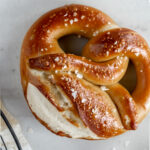
Megan O says
Hi!
I want to make this recipe this week, but I have two questions.
One: does the pretzel dough need to come to room temp after 8 or 30 hours in the fridge, before you start shaping?
Two: most pretzel recipes I see call for 10 cups water and 1/2 cup lye, and no heating. Why do you want the lye wash heated on the stove for your recipe? Is it necessary?
Thank you for your time!
Indi Hampton says
Hi Megan!
You can shape the dough straight out of the fridge!
And for the lye bath, heating it will intensify the impact of the lye-- so the pretzels with have a richer brown, glossy crust and more pretzel flavor. A cold lye bath will still be more pretzel-y than baking soda, but not as deep mahogany. It's totally your call.
As for the concentration of lye, I haven't found it necessary to make the solution more concentrated-- 1% works great (and it's less caustic, less irritating, etc).
Enjoy!
Megan O says
Thank you so much!! I made them today and they turned out BEAUTIFULLY. Wish I could share pictures (they're on my Insta, handle "sageyoku" if you're interested). Really appreciate this recipe!!
A quick question: I used a whisk, a plastic measuring spoon, and a plastic container when working with the lye. Are these items safe to continue using around the kitchen after having been soaked in vinegar (to deactivate the lye) and washed thoroughly? Thank you!
Indi Hampton says
Yes they're totally fine! I'm so happy they came out so great!! Isn't the dough so gorgeous?
Megan O says
Thank you!
Yes the dough is so wonderful and easy to work with 🙂 I made one batch "quick" the same day, and two overnight (these are for my coworkers as a goodbye present on my last day at work, and I don't have a large kitchen). Both batches turned out wonderfully, the beer smell and flavor were definitely more present in the overnight batch.
This turned out so well that I'll be making another batch to freeze for my boyfriend's parents to enjoy when they visit in a few weeks (I won't be here to make them fresh). Thanks again for a stellar recipe!
Tess says
I followed your dough recipe and cold fermented it in the fridge overnight (but did an unheated 4% lye solution for dipping) and they turned out beautifully, very similar to your pictures. Thank you for providing this recipe, especially the gif of how to roll out the pretzels.
Indi Hampton says
Thank you so much!! I could eat a whole batch of these!
Marina says
What a fantastic recipe, thank you so much! I am from Bavaria and these truly tasted like home.
Indi Hampton says
Ahh that's so cool to hear!!
Vatche says
Hello, I am excited to make this recipe today and just wanted to let you know when you select 2x/3x scale it still says 1 packet yeast but the amount changes 😀 Hopefully I would be the only one making that mistake.
Indi Hampton says
Thank you!! Ugh that's so frustrating! I hope it didn't cause a problem for you.
Dave E says
For some reason when i made these the pretzels stuck to the parchment paper afterwards
Indi Hampton says
Hmm that's annoying. I haven't had that problem, but you could always spray the parchment with some cooking spray before hand.
G says
Hello, can these be made without beer? What ought I substitute? Water? Or water and… something else? Thanks! Wish to make these but am feeding it to people in recovery and even though I’m sure it’d cook off, I don’t want to use alcohol.
Indi Hampton says
Of course-- just use water!
Jen says
Hello! Thank you for sharing this recipe. How do you recommend disposing of the lye bath? I assume it's okay to just pour down the drain?
Indi Hampton says
Yep! Just down the drain-- it's basically Draino!